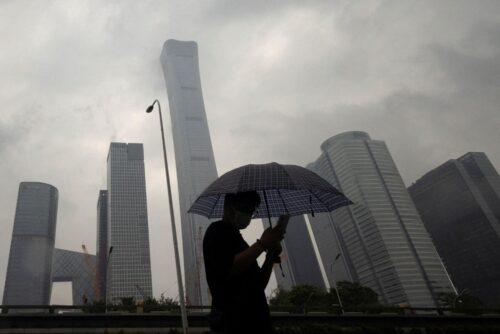China’s meatier, fattier diet is impacting its health, food security, and environment
In four decades, Chinese people went from using food coupons to eating fatty meals delivered via mobile phone apps. The country’s rapid economic rise also means that the foods that Chinese people eat are changing — and most of it’s unhealthy.

In December 2020, China’s National Health Commission (NHC) reported that more than half of Chinese adults were overweight. A total of 16.4% of the adult population were classified as obese.
Those numbers are about nearly double the 29% of overweight adults and the 7.1% of those with obesity in 2002. The expanding waistlines are part of a significant shift in diet for a country of 1.4 billion people.
BBQ restaurants, convenience stores that sell sugar-packed ice cream and snacks, and bubble tea shops have already taken over nearly every city corner, while three years of COVID lockdowns left many residents ordering in while largely confined to their homes. Those dietary changes have raised concern over the risks, both for the country and for its people, on how China is now choosing to feed itself.
A bigger middle class with more money to spend
In the late 1950s and early 60s, an estimated 45 million people starved to death in China. And just three decades ago in 1993, the government issued its last print of the food coupons that were distributed to Chinese citizens to get staples such as rice, oil, eggs, and meat.
The days of food shortages are long over. Within the past few decades, China has built out cities and lifted nearly its entire population above the poverty line due to its rapid economic development. The reforms of the late 1970s led to bigger incomes and a richer middle class: Disposable income has increased by more than 130 times for both rural and urban households (not accounting for inflation). In 1978, an urban household had an average of 343 yuan ($202) to spend. By 2021, that amount increased to more than 47,000 yuan ($7,288 in 2021).
“China has been experiencing profound changes in its diet and lifestyle patterns over the past four decades,” Yanzhong Huang, senior fellow for global health at the Council on Foreign Relations (CFR), told The China Project yesterday. “These changes are driven by economic growth and urbanization, which led to the shift towards a more affluent lifestyle and easier access to a variety of processed and high-calorie foods. This shift has resulted in the move away from traditional dietary patterns that typically consisted of a balanced mix of vegetables, grains and meat.”
China’s growing taste for meat and fat
With more money in their pocket, Chinese consumers have also grown hungry for fattier, meatier foods. Many traditional ways of eating are being replaced with diets that “include the adoption of a more Westernized food — which includes higher consumption of fast food, sugary beverages, processed snacks, and convenience foods that are high in salt, sugar, and oil, a sedentary lifestyle, and decreased physical activity levels encouraged by urbanization and increased screen time,” Huang said.
While there have been a number of official studies that measure China’s eating habits, it is difficult to compile accurate consumption data of a country of 1.4 billion people. National averages can often obscure important variations between demographic groups and geographic regions in the country.
However, overall trends have shown that China’s diet is quickly becoming more like that of the average American. National nutrition surveys have estimated that China is eating significantly less carbohydrates and much more meat and fat. Average energy intake from carbohydrates declined from 62.6% in 1991 to 50.6% in 2015, while that from fat grew from 24.0% to 35.8% during the same period — a figure similar to that in Western countries such as the United States.
Health risks climb, risking strained healthcare systems
The shift in diet has also contributed to a rise in obesity, high cholesterol, and type 2 diabetes across the country, fueling concern that Chinese peoples’ food choices may weigh on the country’s already strained healthcare system.
In China, overweight and obesity rates of urban and rural residents of all ages are increasing, from 20.4% in 2000 to 34.3% in 2020. Among children, if no intervention is taken, some predictions have estimated that the obesity rate for school-aged kids will reach 28% by 2030, or 49.48 million overweight and obese children.
Chronic diseases are also on the rise. Adult diabetes grew from 1% in 1980 to 11.9% in 2020, and its prevalence is projected to increase from 8.2% to 9.7% from 2020–2030, according to a Lancet report published this year. Total costs of diabetes would increase from $250.2 billion to $460.4 billion during that same period, or from 1.58% to 1.69% as a percentage of GDP, suggesting that the growth in the economic burden of diabetes will outpace the growth of China’s economy.
Meanwhile, China’s salt intake, among the highest in the world, is raising concerns over high blood pressure and risks for heart disease and stroke: About 27.5% of Chinese adults have high blood pressure (hypertension). Cardiovascular disease (CVD) is the number one killer in China, accounting for 53.2% of all deaths caused by noncommunicable diseases (NCDs). (The government has pledged to reduce the mortality rate of CVD by more than half by 2030 — to less than 190.7 deaths per 100,000 people.)
“Managing and treating these diseases place a huge burden on China’s fragile healthcare systems,” Huang told The China Project. “In the meantime, the increased disease burden is leading to productivity losses and hindering China’s efforts to achieve common prosperity…families with members suffering from NCDs are more likely to return to poverty.”
The COVID pandemic, which largely left people confined to their homes for the past three years under snap lockdowns, is also being cited as a new cause of rising obesity, especially in children. A large number of locked-in residents leaned on deliveries or take outs from restaurants, many of which serve rich, greasy food with just a few clicks on a screen.
How to secure food for 1.4 billion people
The rise in consumption of processed and high-calorie foods may also affect the demand for certain agricultural products, thereby posing a risk to China’s food security. It has raised concern on how China will be able to produce enough safe food if its population starts eating like Americans.
China’s growing taste for meat may drive a corresponding decrease in demand for grain, leading to a drop in grain prices. “This decline in prices could discourage farmers from growing grain, exacerbating China’s existing food security concerns,” Huang told The China Project.
China has approximately 20% of the world’s population, but only 10% of its arable land and only 5% of its water. In the U.S., it takes about one acre to feed the average U.S. consumer. China, on the other hand, only has about 0.2 acres of arable land per person, including fields degraded by pollution.
Higher demand for animal-based foods and restricted access to farmable land means that China must rely on large amounts of imports, particularly for meat and soybeans used in animal feed. China is the world’s largest importer of pork and the fourth-largest buyer of agricultural land overseas. Soybeans, primarily for animal feed, are largely imported through major supplier countries including Brazil (53%), the United States (34%), and Argentina (7%).
China’s reliance on other countries to feed its own population has sparked the Chinese government’s push for self sufficiency, to ensure that “the rice bowls of the Chinese people are filled with Chinese grain.” In 2022, Xí Jìnpíng 习近平 issued a “Big Food” concept, which calls for an effective supply of major food groups and protein diversification, improving the efficiency of domestic agricultural production, and reducing food waste.
A big environmental footprint
China’s production and consumption of processed and unhealthy foods also has implications on the overall environmental impact, exacerbating the problems of land use, water consumption, pollution, and greenhouse gas emissions.
The United Nations’ Food and Agricultural Organization (FAO) estimated that China’s food system emitted 1.9 billion tons of CO2 equivalent in 2020, accounting for 14% of the country’s total emissions that year. That amount is also roughly the same as the total annual emissions of Russia, the world’s fourth largest polluter.
Across the world, around one-third of total greenhouse gas emissions come from the production of food, and red meat production is by far the largest driver. China is the world’s largest meat producer, and accounts for 28% of the world’s rice and 22% of its corn cultivation. Meanwhile, China is also the world’s second-largest consumer of beef, with beef consumption per capita projected to rise 8% by 2030.
The latest dietary guidelines released in 2022 by the Chinese government considers the impact of dietary choices on the broader environment, and would help drive the country’s goal of becoming carbon neutral by 2060. By one conservative estimate, 146 to 202 million metric tons of greenhouse gas emissions from agriculture could have been avoided annually if the Chinese population followed the dietary guidelines released in 2016.
But China will chart its own path to cut climate emissions, Xi Jinping told dozens of officials yesterday, and the new food guidelines are an attempt to bring people’s diets in line with the Communist Party’s climate and food security ambitions — including becoming more self-sufficient in domestic food production. So its citizens may soon be obliged to eat more greens and grains instead of the meatier, fattier meals that they’ve become accustomed to.
“China’s commitments are unswerving, but the path towards the goals as well as the manner, pace and intensity of efforts to achieve them should and must be determined by the country itself, rather than swayed by others,” Xi said.




